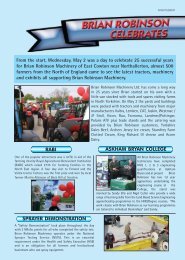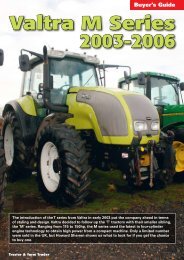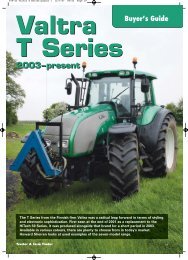HSE LOLER regulations factsheet - Brian Robinson Machinery
HSE LOLER regulations factsheet - Brian Robinson Machinery
HSE LOLER regulations factsheet - Brian Robinson Machinery
- No tags were found...
You also want an ePaper? Increase the reach of your titles
YUMPU automatically turns print PDFs into web optimized ePapers that Google loves.
●workers should have sufficient training andinstructions so they can ensure that liftingequipment is safe to use. For example when anuntrained casual worker uses a foreloader, trainingshould be given on the daily checks needed toensure the safety of hydraulic fittings and mountingpoints for attachments and the loader.Thorough examinationLifting equipment may need to be thoroughly examinedby a competent person when:●it is first put into service;●●the first time it is put into service unless it has notbeen used before and has an EC declaration ofconformity not more than 12 months old, or it issecond-hand and has a current report of thoroughexamination;at the following intervals where it is exposed toconditions which could cause deterioration andresult in dangerous situations:- every six months for any equipment used forlifting people and for all accessories (such aschains and slings) and every twelve monthsfor other lifting equipment; or●●●following major refurbishment or repair;after installation at a new location; andat intervals suitable to detect deterioration arisingfrom wear and tear.Thorough examination is to protect both operators andpeople in the vicinity of lifting operations who may be atrisk if lifting equipment suddenly fails.Equipment which lifts loads over or in close proximity topeople should be thoroughly examined.Equipment that does not lift loads over or in closeproximity to people and where the operators of theequipment are protected does not need to be thoroughlyexamined. Such protection would be a safety cab.Working to the above criteria, lifting equipment such as:●●fork-lift trucks and foreloaders on tractors withoutadequate operator protection or where otherpeople are working in the close vicinity will needthorough examination; andforeloaders on tractors with safety cabs, telescopicloaders and fork-lift trucks with operator protectionand where no other people work in the vicinity willnot normally need thorough examination.While thorough examination of tractor foreloaders willnot normally be necessary, a regular check of aforeloader’s hydraulic hoses and mounting points forattachments should be part of normal safe operation andmaintenance.However, you should assess your work equipment andworking practices for the risks involved and decide whichitems need thorough examination in your particularcircumstances.Where lifting equipment is assessed as needing athorough examination, you should ensure that it is done:●- in accordance with the time intervals in anexamination scheme prepared by acompetent person;each time that exceptional circumstances occurwhich are liable to jeopardise the safety of thelifting equipment, eg after accident damage.When lifting equipment requires a thorough examinationyou will need to arrange for this to be carried out by acompetent person. This will normally be an independentcompetent person from outside the undertaking, such asan engineer.You should ensure that the competent person chosen tocarry out the thorough examination has the appropriatepractical and theoretical knowledge and experience ofthe lifting equipment concerned to enable them to detectdefects or weaknesses which it is the purpose of theexamination to discover. Also they should be able toassess the importance of the defects in relation to thesafety and continued use of the equipment.When any lifting equipment which requires a thoroughexamination under this regulation leaves your business,then a copy of its current thorough examination reportshould be available, eg if you hire a fork-lift for your ownuse or you lend yours to a neighbour.Reports and defectsA competent person making a thorough examination foryou should notify you immediately of any defect which isor could become a danger to people. The competentperson should also send a copy of the report to <strong>HSE</strong>where there is an existing or imminent risk of seriouspersonal injury. (Where the Local Authority is theenforcement body it should be sent to them instead.)If you are notified of a defect you should ensure that thelifting equipment is not used before the defect isrectified, or that it is rectified within the time specified inthe competent person’s report.







